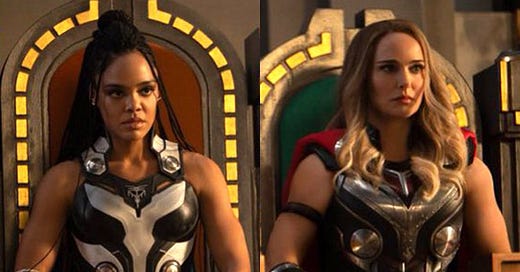Sword & Hammer: The Women of Thor
New Yap contributor Jackson Mahuron looks at the representation of females in "Thor: Love and Thunder" and other MCU Phase 4 efforts.
In Taika Waititi’s latest Marvel film, the characterization of two prominent female figures exposes a recurring problem within the Marvel Cinematic Universe and shines a light on the hopeful future of women in Phase Four.
After nearly a decade and a half of the MCU dominating the movie theaters, “Thor: Love and Thunder” has finally joined as the 29th movie and 34th overall installment. As fans are coming out of the theaters with seemingly mixed reviews (myself included), “Phase Four” has been a point in the franchise where many people are seemingly jumping ship.
Personally, I am still on board, as this franchise has decided to take bold risks in introducing new and unique characters while also allowing for new and stylistic directors to breathe some life into what I consider to be a lackluster design aesthetic throughout these movies. Easily the most exciting part of being this far into the franchise is that Disney is ready to take a few calculated swings with what characters they bring to the mainstream, which has allowed for a lot of representation for both women and people of color.
The Bechdel Test is a way to evaluate films to see if the minimum bar of female representation is met. The requirements to pass the test are simple: two named characters that are women must have a conversation about anything other than a male character in the movie. While it seems like an easy requirement to pass, the MCU isn’t always delivering. Out of the 29 movies in the mega franchise, only 18 of them actually meet these requirements.
The movies from phase four are also the only ones to have every movie (so far) pass the Bechdel Test. While it isn’t the perfect tool to determine what film has the best female representation or even anything above the minimum requirement, it is no coincidence that the phase of movies with this track record has also introduced the most compelling new women the MCU has to offer.
In “Endgame”, fans criticized the women team-up scene between Gamora, Nebula, Mantis, Pepper, Valkyrie, Shuri, Okoye, Scarlet Witch, Captain Marvel and the Wasp, saying that it didn’t feel earned. I think it’s a fair critique too because, of the characters in the scene, the only characters to have conversations with each other in previous films include the three women from the “Guardians of the Galaxy” and the two women from “Black Panther”. At this point of the franchise, none of these characters have talked to the other women from outside their respective movies.
The scene wasn’t bad because it felt like forced inclusivity, it was bad because the characters didn’t earn a moment like that.
Prior to phase four, the women were constantly being sidelined to accommodate screen time to other male characters. Luckily, phase four has brought us some really great arcs for older side characters and new characters altogether. In this new Marvel Era, we’ve been gifted with The Scarlet Witch, Kate Bishop as the second Hawkeye, the original comic Captain Marvel Monica Rambeau, America Chavez, Kamala Khan, and many more.
While Love and Thunder does bring back Natalie Portman and Tessa Thompson in their respective roles as Jane Foster and Valkyrie, they were sadly relegated to the sidelines for a much less interesting Thor to take the spotlight. My only complaint about Jane Foster's representation was that there simply isn't enough of it. Her portrayal of The Mighty Thor was almost as powerful as her character’s struggle (spoiler warning) with stage four cancer.
Portman brought refreshing moments of heart and tragedy to a movie that felt like it was trying too hard to be funny. If I had it my way, I’d cut Thor out of the plot altogether. Jane’s plotline was more than enough to hold an entire movie and she balanced and paralleled Christian Bale’s Gorr the God Butcher character really well.
Both were two mortals abandoned by the gods in a time of need and turned to dangerous weapons that saved their lives, and set them on a path of self destruction. Their themes map so perfectly, it bewilders me that they would muddy the story with an undercooked Thor plotline that has little satisfaction for me personally.
Valkyrie was really fun to watch as a side character in this movie as well. It was tough to watch a prominent queer woman of color to take the sidelines to Korg, who had a scene that played off his seemingly out of knowhere gay romance as a cheap joke. Replacing Thor and Korg to make more room for Jane and Valkyrie overall would have been a huge improvement for me.
Almost all of Thor’s concern for Jane could have been substituted with the guilt of Valkyrie not wanting to lose another friend in battle.
While I can’t say I particularly loved “Love & Thunder,” the women really shined through. I am excited to see these characters move into the spotlight — where they belong.




